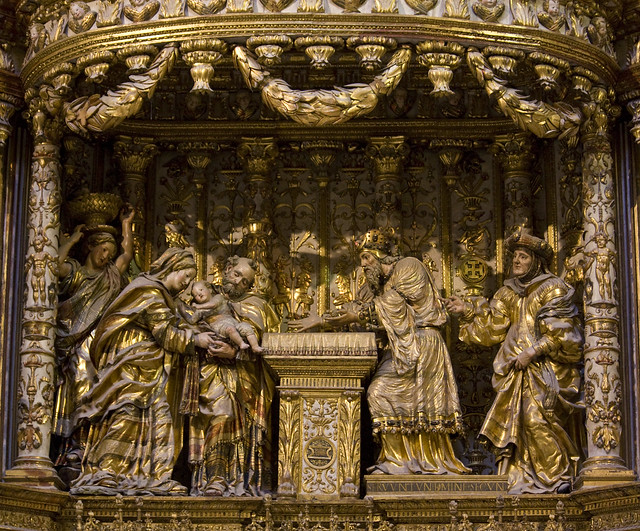
It has been remarked that the opening chapters of St Luke's Gospel are like a musical, where at high points people spontaneously sing canticles! This observation is rather accurate, but it is noteworthy that the songs are introduced whenever heaven and earth meet, when the presence of God acting in salvation history is made especially manifest. And the composer and conductor of this musical outburst is none other than the Holy Spirit, who in each occasion (except in the case of Mary, for she is already full of grace) fills Zechariah and Simeon, and inspires them to break into song. In today's feast, we recall the event that occasioned the last of these songs, thus bringing to a close the Advent and Christmas scenes of the first Act, as it were, of Luke's Gospel.
In each of these incidents, where Old and New Testaments worlds meet, St Luke is showing the fulfillment of God's promise to his chosen people, Israel, in the person of his Son, Jesus. He is the Messiah, the longed-for redeemer and leader of Israel. But it is also significant to note St Luke's warmth towards Jewish laws, customs and people. His portrayal of Simeon makes clear that he was a God-fearing and pious Jew, who was filled with the Holy Spirit. And this same Spirit who acted in the salvation history of Israel, continues to work in the salvation history of the nascent Church, as we see in Acts, which is St Luke's sequel to his Gospel. Therefore, although Luke himself does not write it, he expresses in his Gospel what St John records the Lord as saying: "Salvation is from the Jews" (Jn 4:22). Thus, the Messiah comes from the Jewish people, and so, as Simeon says, he is "for glory to [God's] people Israel" (Lk 2:32b).
But there has also been a development in Messianic theology between the song of Zechariah (the 'Benedictus') and the song of Simeon (the 'Nunc Dimittis'). While Zechariah speaks exclusively of the redemption of Israel, and the salvation of the House of David (see Lk 1:68-29), Simeon includes the fact that God has prepared his salvation for "all peoples", and that the Christ is "a light for revelation to the Gentiles". For the Messiah did not just come to deliver the Jews, but to deliver all humankind. Because we are all God's people, each lovingly created and held in being by him. And it is precisely because Jesus saves all people that we can say he is the glory of Israel. Because in his person he perfects the mission of God's chosen people, which is to be a sign of God's presence and saving mercy in the universe.
In fact, a sign of this universal mission of the Jews was indicated by the menorah, the eternal lamp that burnt in the Temple. Interestingly, both Zechariah and Simeon's songs take place in the Temple, but only in Simeon's case is Christ physically present. Thus St Luke portrays Christ as the physical embodiment of what the menorah symbolized: He is the true Light that enlightens all nations. Moreover, Christ is called the glory of Israel. Locating this within the Temple, St Luke seems to have the shekinah in mind. In Jewish understanding this was the dwelling place of God's glory or his divine presence, which was manifest above the Tabernacle in the Holy of Holies of the Temple. Hence, Christ is the incarnation of God's glory, the living sign of God's presence among his people. Therefore Christ himself is the Temple (see John 2:19) because he is everything the Temple stood for, and was directed towards: namely the place where heaven and earth meet, and for the salvation of God's people. As Simeon said, Jesus is God's salvation whom he has seen with his own eyes.
We too, as Christians, have seen Christ with our own eyes, present in the Eucharist, and in the Temple of our bodies. Thus, we are part of the salvation that comes from the Jews. On this holy feast day, let us recall that "we too are part of the ageless pilgrimage of God’s people through history. In the footsteps of the prophets, the apostles and the saints, we are called to walk with the Lord, to carry on his mission, to bear witness to the Gospel of God’s universal love and mercy" (Benedict XVI). In short, we are called to bear Christ's light to the world.
 From ancient times we have looked in wonder upon the stars and other ‘heavenly bodies’, and used them, fruitfully, to guide us. In a world of growth and decay, the heavens seem to be enduring and unchanging, celestial constants suspended above an ever-changing world. Against the dark sky of night they shine bright and hold their steady, unchanging course. It is little wonder then, that in our awe and fascination for such things, and in our knowledge of their usefulness in safely guiding us, that we would employ their titles analogously to highlight the enduring qualities of Our Lady and Our Blessed Lord.
From ancient times we have looked in wonder upon the stars and other ‘heavenly bodies’, and used them, fruitfully, to guide us. In a world of growth and decay, the heavens seem to be enduring and unchanging, celestial constants suspended above an ever-changing world. Against the dark sky of night they shine bright and hold their steady, unchanging course. It is little wonder then, that in our awe and fascination for such things, and in our knowledge of their usefulness in safely guiding us, that we would employ their titles analogously to highlight the enduring qualities of Our Lady and Our Blessed Lord.






















